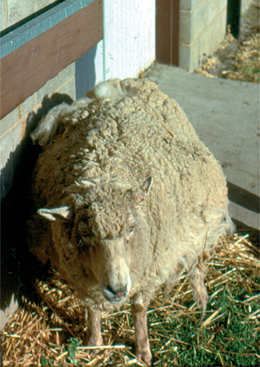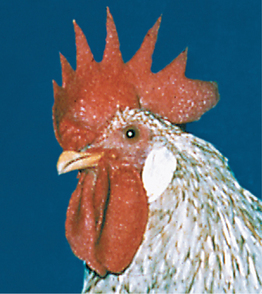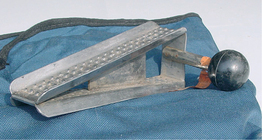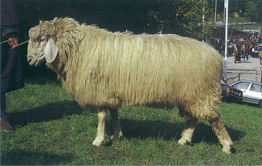W
W chemical symbol, tungsten (wolfram); tryptophan; watt.
W/ with. Used in medical records.
wafers compressed roughage in flat plates useful for feeding to animals in transit.
wahi dermatitis caused by Onchocerca gutturosa.
Walchia americana one of the harvest mites that cause trombiculidiasis in domestic animals.
Waldenström’s macroglobulinemia [vahl’den-str rm] see Waldenström’s macroglobulinemia.
rm] see Waldenström’s macroglobulinemia.
collected w. the horse is held in but is encouraged to walk vigorously by the rider.
free w. a walk on a loose rein with the head free.
Walker hound see Treeing Walker coonhound.
walking [wawk’ing] a normal slow gait in all species.
wall [wawl] a structure bounding or limiting a space or a definitive mass of material.
abdominal w. see abdominal wall.
w. chart see calendar charts, shed sheet.
w. tick see Haemaphysalis bancrofti.
wallow mud bath frequented by pigs, elephants, red deer, hippopotami as a cooling aid.
wanderers [wahn’d r–
r– r] see neonatal maladjustment syndrome.
r] see neonatal maladjustment syndrome.
wandering [wahn’d r-ing] slow, purposeless walking.
r-ing] slow, purposeless walking.
wannakai see Rhodomyrtus macrocarpa.
war bridle see Yankee war bridle, Magner war bridle.
Warburg–Dickens scheme [vahr’boorg] see pentose phosphate pathway.
warm providing a sensation of approximately body heat.
warm-up pre-race exercise by a horse.
Warren hound see Portuguese podengo.
wart [wort] see fibropapilloma.
w. h. disease see African swine fever.
washout [wahsh’out] to disperse or empty by flooding with water or other solvent.
w. fish venomous fish in the family Tetrarogidae; closely related to the scorpionfish.
w. acetonemia see primary ketosis.
watch eye lay term for heterochromia iridis; walleye.
w.-damaged grain recorded as toxic due to tunicamycin in mixture produced probably by fungi.
w. deprivation the animals are cut off from any source of water. May be by accident or neglect.
distilled w. water that has been purified by distillation.
w. drowning a primitive method of euthanasia, especially for unwanted, newborn animals.
w. marker decay curve the curve of declining concentration of a water marker in intravascular fluid.
water betony see Scrophularia aquatica.
water bloom see algae, algal poisoning, cyanobacteria.
water bush Myoporum acuminatum.
water couch Paspalum paspalodes.
water figwort see Scrophularia aquatica.
water pepper Polygonum hydropiper.
water-soluble vitamin see water-soluble vitamin.
waterfowl a loose term for anseriform birds especially ducks.
watering the giving of water to animals.
w. devices includes, troughs, ball-cock float valves, hydraulic rams, windmills, drinking nipples.
waterpens [Af.] Galenia africana poisoning.
waters [waw’t rz] popular name for amniotic fluid. Called also waterbag.
rz] popular name for amniotic fluid. Called also waterbag.
Waterside terrier an early name for the Airedale terrier.
watery pork the pale, soft exudative pork of pigs affected by porcine stress syndrome.
wattage [waht’ j] the output or consumption of an electric device expressed in watts.
j] the output or consumption of an electric device expressed in watts.
ovine w’s identical to caprine but much less common.
wattmeter [waht’me-t r] an instrument for measuring wattage.
r] an instrument for measuring wattage.
light w’s the electromagnetic waves that stimulate the retina. See also vision.
S w. a downward deflection of the QRS complex following the R wave in the normal electrocardiogram.
U w. seen in the human electrocardiogram; represents repolarization of Purkinje cells.
wave mouth the tables of the molar teeth have a wavelike appearance due to uneven wear.
waxing [wak’sing] covering with wax.
WAZA World Association of Zoos and Aquariums.
WBC white blood cell (leukocyte); white blood (cell) count.
weanling [wēn’ling] see weaner.
w. enteritis see coliform gastroenteritis.
wear and tear pigment lipofuscin. See also xanthosis.
weather climate, climatic conditions.
w. stain said of wool. See fleece rot.
w. stress cold, heat, wet stress.
weavemouth uneven wear of teeth associated with accelerated attrition. See also wave mouth.
weaver syndrome see progressive degenerative myeloencephalopathy.
web [web] 1. network of tissue, reasoning or electronic. 2. a tissue or membrane. See also webbed.
causation w. a network of interacting risk factors.
webbed [webd] connected by a membrane or strand of tissue.
Weber–Christian disease see nodular nonsuppurative panniculitis.
wedeloside carboxyatractyloside found in Wedelia asperrima.
wedge [wej] a solid rectangular object, thin at one end, thick at the other.
WEE Western equine encephalomyelitis.
weed 1. a plant growing out of place. 2. of horses, see sporadic lymphangitis.
Weed method problem knowledge coupler system.
Wei qi in traditional Chinese medicine, the equivalent of the immune system. See also Qi.
weight [wāt] heaviness; the degree to which a body is drawn toward the earth by gravity. See also Tables 2.1 and 2.2.
apothecaries’ w. an outmoded system of weight used in compounding prescriptions based on the grain (equivalent 64.8 mg). Its units are the scruple (20 grains), dram (3 scruples), ounce (8 drams) and pound (12 ounces). See also Tables 2.2 and 2.3.
birth w. weight of the newborn at the time of birth.
body w.-to-surface area determination of many drug dosages is physiologically more accurate when based on body surface area rather than body weight; used particularly in cancer chemotherapy. For conversion table for use in dogs see Table 20.
metric w. see Tables 2.1 and 2.2.
molecular w. (mol. wt.) the weight of a molecule of a chemical compound as compared with the weight of an atom of carbon- 12; it is equal to the sum of the weights of its constituent atoms. See also Table 4.
weir vine Ipomoea polpha subsp. weirana.
Welch bacillus [welch] see Clostridium perfringens.
well waters can be poisonous; see nitrate, sodium chloride poisoning.
Welsh black dual-purpose black cattle breed originating in Wales, UK.
Welsh mountain sheep a white or tan-faced wool and meat sheep; males are horned, females polled.
Welsh pig a long-faced, lop-eared, white pig, originating in Wales, UK.
< div class='tao-gold-member'>
 l-nis] believed to occur when the tonic flow of impulses from the reticular activating system exceeds the critical level for sustaining consciousness; reduction of reticular activating system activity is the basis of the pharmacological induction of sedation.
l-nis] believed to occur when the tonic flow of impulses from the reticular activating system exceeds the critical level for sustaining consciousness; reduction of reticular activating system activity is the basis of the pharmacological induction of sedation. lz] the disease caused by Hypoderma. Includes damage to the hides where the larvae emerge, some cases of choke caused by periesophagitis, posterior paresis or paralysis in a small percentage of infested cattle due to a reaction to dead H. bovis in the spinal canal, and some deaths due to invasion of the brain or to anaphylaxis.
lz] the disease caused by Hypoderma. Includes damage to the hides where the larvae emerge, some cases of choke caused by periesophagitis, posterior paresis or paralysis in a small percentage of infested cattle due to a reaction to dead H. bovis in the spinal canal, and some deaths due to invasion of the brain or to anaphylaxis. r-in] a coumarin compound used as an anticoagulant in humans and as a rodenticide, with serious toxicity implications for all species. It is readily absorbed from the intestinal tract and acts to inhibit the reduction of oxidized vitamin K, resulting in a depletion of active vitamin K that is required for carboxylation of coagulation factors VII, IX, X and II. Accidental poisoning in all species causes spontaneous hemorrhage and death due to anemia. Less severe cases often show pulmonary hemorrhage. In pigs it is the legs that are affected preferentially and in dogs hemorrhage into the anterior mediastinum and lungs is common. Vitamin K is the specific antidote.
r-in] a coumarin compound used as an anticoagulant in humans and as a rodenticide, with serious toxicity implications for all species. It is readily absorbed from the intestinal tract and acts to inhibit the reduction of oxidized vitamin K, resulting in a depletion of active vitamin K that is required for carboxylation of coagulation factors VII, IX, X and II. Accidental poisoning in all species causes spontaneous hemorrhage and death due to anemia. Less severe cases often show pulmonary hemorrhage. In pigs it is the legs that are affected preferentially and in dogs hemorrhage into the anterior mediastinum and lungs is common. Vitamin K is the specific antidote.
 r] 1. a clear, colorless, odorless, tasteless liquid, H2O. 2. an aqueous solution of a medicinal substance.
r] 1. a clear, colorless, odorless, tasteless liquid, H2O. 2. an aqueous solution of a medicinal substance. r-shed] ischemic damage, caused by slow flow of blood because of poor arterial perfusion at the periphery of a circulatory field where there is an inadequate collateral circulation.
r-shed] ischemic damage, caused by slow flow of blood because of poor arterial perfusion at the periphery of a circulatory field where there is an inadequate collateral circulation. n- krik] James D. Watson (1928- ) and Francis H.C. Crick (1916-2004); along with Maurice Wilkins, codiscoverers of the structure of the DNA molecule and recipients of the 1962 Nobel Prize for Physiology or Medicine. See double helix.
n- krik] James D. Watson (1928- ) and Francis H.C. Crick (1916-2004); along with Maurice Wilkins, codiscoverers of the structure of the DNA molecule and recipients of the 1962 Nobel Prize for Physiology or Medicine. See double helix.
 r] the SI unit of magnetic flux which, linking a circuit of one turn, produces in it an electromotive force of one volt as it is reduced to zero at a uniform rate in one second.
r] the SI unit of magnetic flux which, linking a circuit of one turn, produces in it an electromotive force of one volt as it is reduced to zero at a uniform rate in one second.
 –līt] a form of calcium oxalate (calcium oxalate dihydrate). Found in oxalate uroliths.
–līt] a form of calcium oxalate (calcium oxalate dihydrate). Found in oxalate uroliths. l pah-lād’] ultrastructural markers of endothelial cells in primates and horses.
l pah-lād’] ultrastructural markers of endothelial cells in primates and horses.



